How to Develop Custom Fleet Management Software for Your Mircomobility Business
If you plan to build a micromobility business, you need fleet management software as a part of your ecosystem. Learn how to build such a system, what features it should have, and how much it costs.
What is a fleet management system?
Any micromobility business has a fleet. This fleet can consist of e-bikes, scooters, electric motorcycles, and even cars. Often, they are located across the whole city at random places, so people can find the nearest vehicle and use it at any time.
To control this ecosystem of micromobility vehicles, you need fleet management software. It’s a centralized system that tracks each vehicle through IoT technology. A fleet management system detects vehicle’s:
- Location
- Speed
- Temperature
- Fuel or charge level
- Direction
- Distance traveled
A fleet management system is a centralized hub that allows you to track each vehicle in your fleet through IoT technology
Apart from passively tracking data, such a system can also:
- Lock or unlock the vehicle
- Start an alarm
- Send and receive notifications
- Register vehicles
- Alert fleet managers in case of damage, misplacement or low battery charge
- Create insightful reports
Basically, a fleet management system is a piece of software that ties together you, your vehicles, and your user-facing app.
Benefits of a micromobility fleet management system
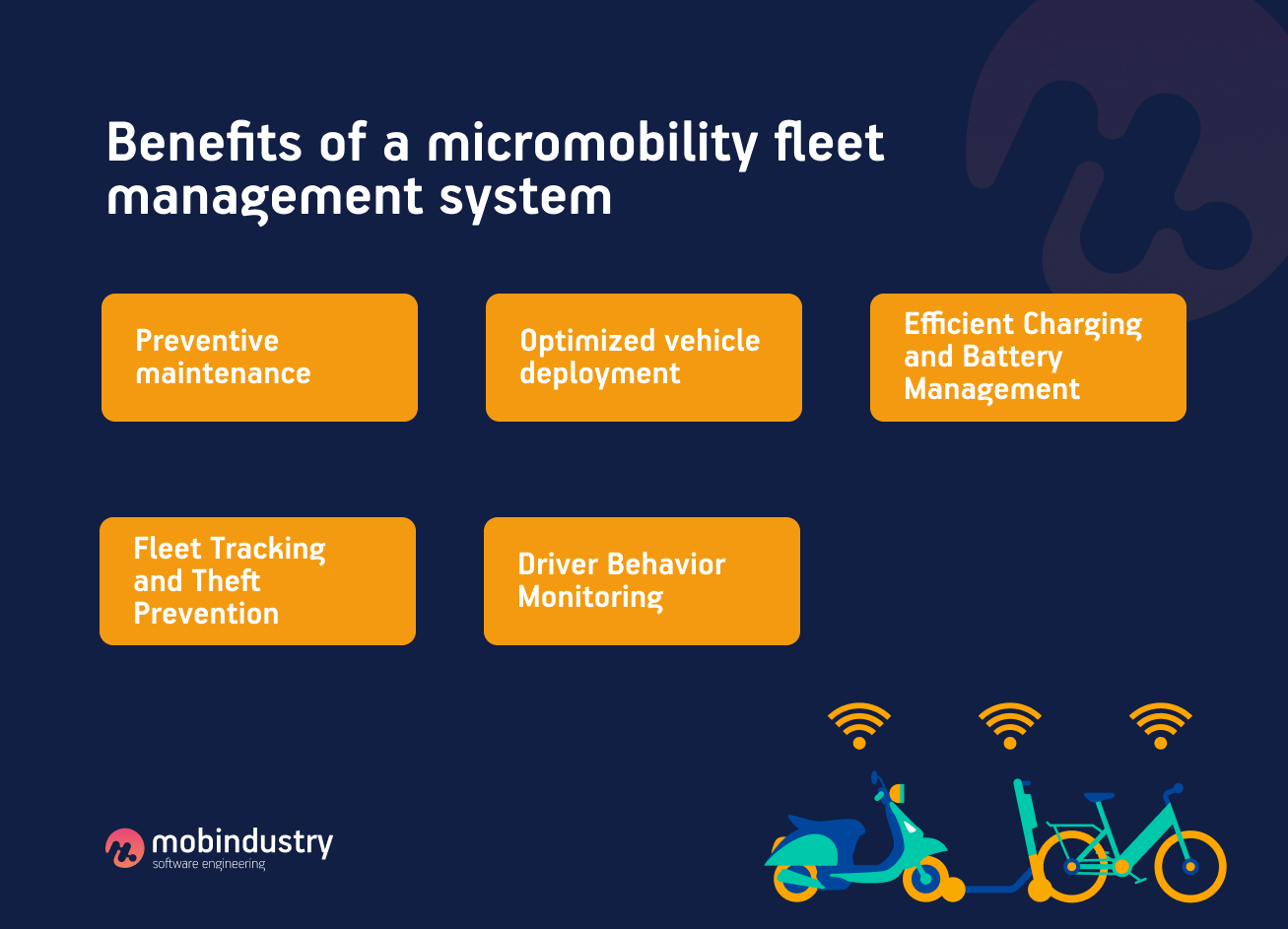
Preventive maintenance
Micromobility vehicles, such as electric bikes and scooters, require regular fleet maintenance to ensure they are in good condition and perform efficiently. Vehicle fleet management software can help schedule and track regular preventive vehicle maintenance tasks such as battery replacements, tire replacements, and routine inspections. This can help reduce unexpected breakdowns and increase the lifespan of the vehicles.
Optimized vehicle deployment
Your software can analyze demand and usage patterns such as peak demand times and popular locations. This can help fleet managers deploy vehicles to the most demanded areas, reducing idle time and maximizing revenue generation.
Efficient Charging and Battery Management
Electric micromobility vehicles require regular charging to operate. Fleet management software can help optimize charging schedules and reduce energy consumption. For instance, fleet managers can take advantage of lower electricity rates and reduce overall charging costs by scheduling charging during off-peak hours.
Fleet Tracking and Theft Prevention
Micromobility vehicles can be vulnerable to theft or damage. Your fleet management software can help track the location of vehicles with GPS tracking devices and alert fleet managers if a vehicle goes outside its designated area or is moved without authorization. This can help prevent theft and reduce the risk of damage to vehicles.
Driver Behavior Monitoring
Monitoring driver behavior can help improve vehicle efficiency and reduce maintenance costs. Fleet management software can help track data such as speed, acceleration, and braking patterns and provide feedback to drivers on how to drive more efficiently. This can help reduce wear and tear on vehicles and increase their lifespan.
How fleet management systems work
Fleet management systems use a combination of hardware and software tools to collect and analyze data related to vehicle performance, driver behavior, and other key metrics.
They use telematics to connect to vehicles over cloud platforms. The connection is provided by an IoT device installed on the vehicle. For example, scooter-sharing businesses use IoT controllers with sensors that collect and send data to a fleet management system. Some scooters have in-built sensors, but the logic is the same.
IoT controllers can use several data connection protocols to transfer data from a scooter to a fleet management system. The most common protocols include:
- Cellular networks. Scooter controllers can use cellular networks such as 3G, 4G, or 5G to transfer data to the system.
- Bluetooth. Some scooter controllers use Bluetooth to transfer data to a nearby device such as a smartphone or tablet, which can then upload the data to the fleet management system..
- Wi-Fi. Scooter controllers can use Wi-Fi to connect to the internet and transfer data to the fleet management system.
- LoRaWAN. Low-Power Wide-Area Network (LoRaWAN) is a protocol for long-range communication between IoT devices and gateways. Some scooter controllers may use LoRaWAN to transfer data to a nearby gateway, which can then forward the data to the system.
The specific data connection protocol an IoT controller uses depends on several factors, including the vehicle’s location, the availability of cellular or Wi-Fi networks, and the requirements of the fleet management system.
Let’s now look at the fleet management software features you absolutely need to have in your micromobility fleet management system.
Must-have features for a fleet management system
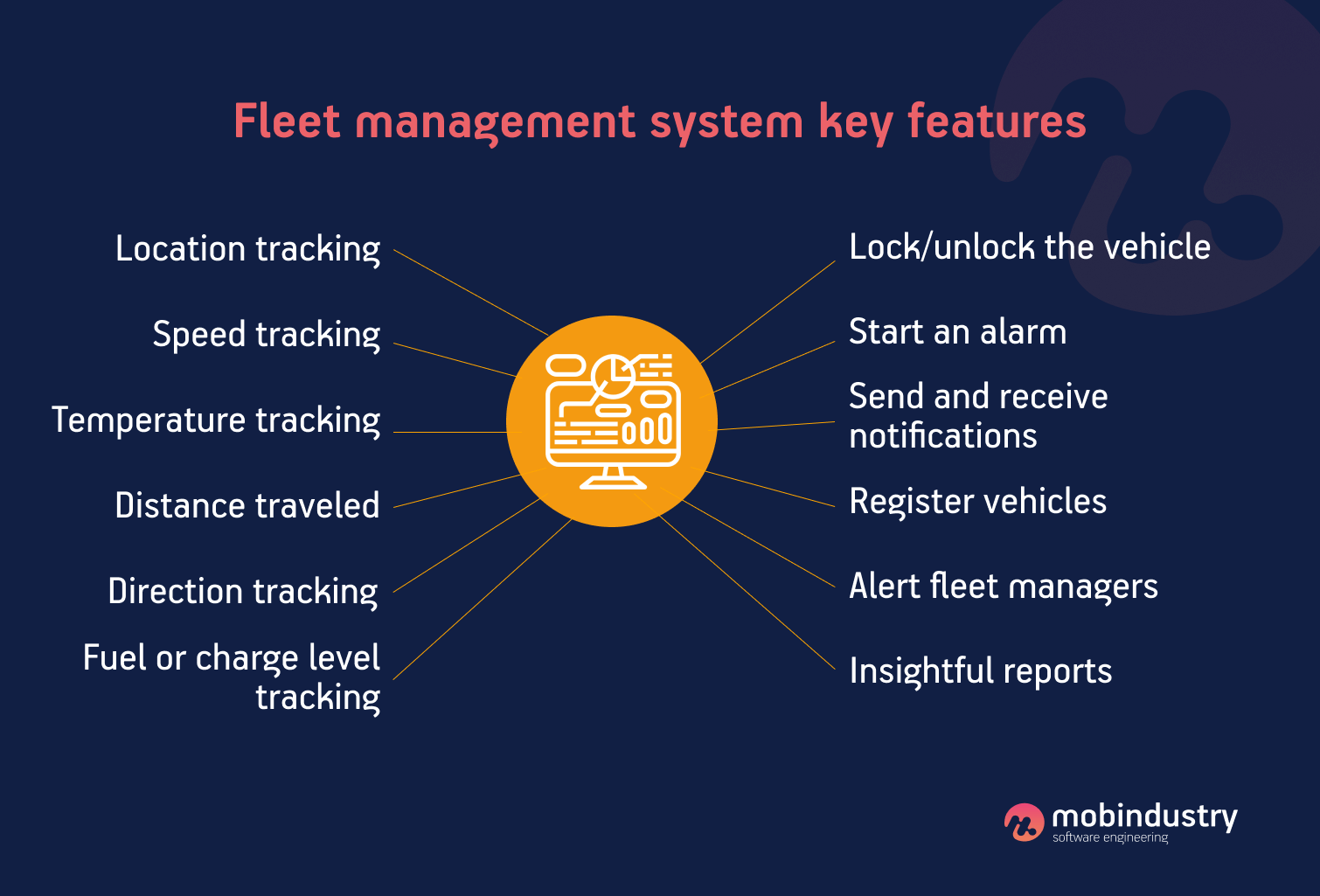
Real-time location tracking
You should be able to check the exact location of each vehicle in your park, as well as its speed and direction if it’s moving. This information helps staff to distribute the vehicles evenly or place them in high-demand areas, as well as collect them for maintenance.
Vehicle condition monitoring
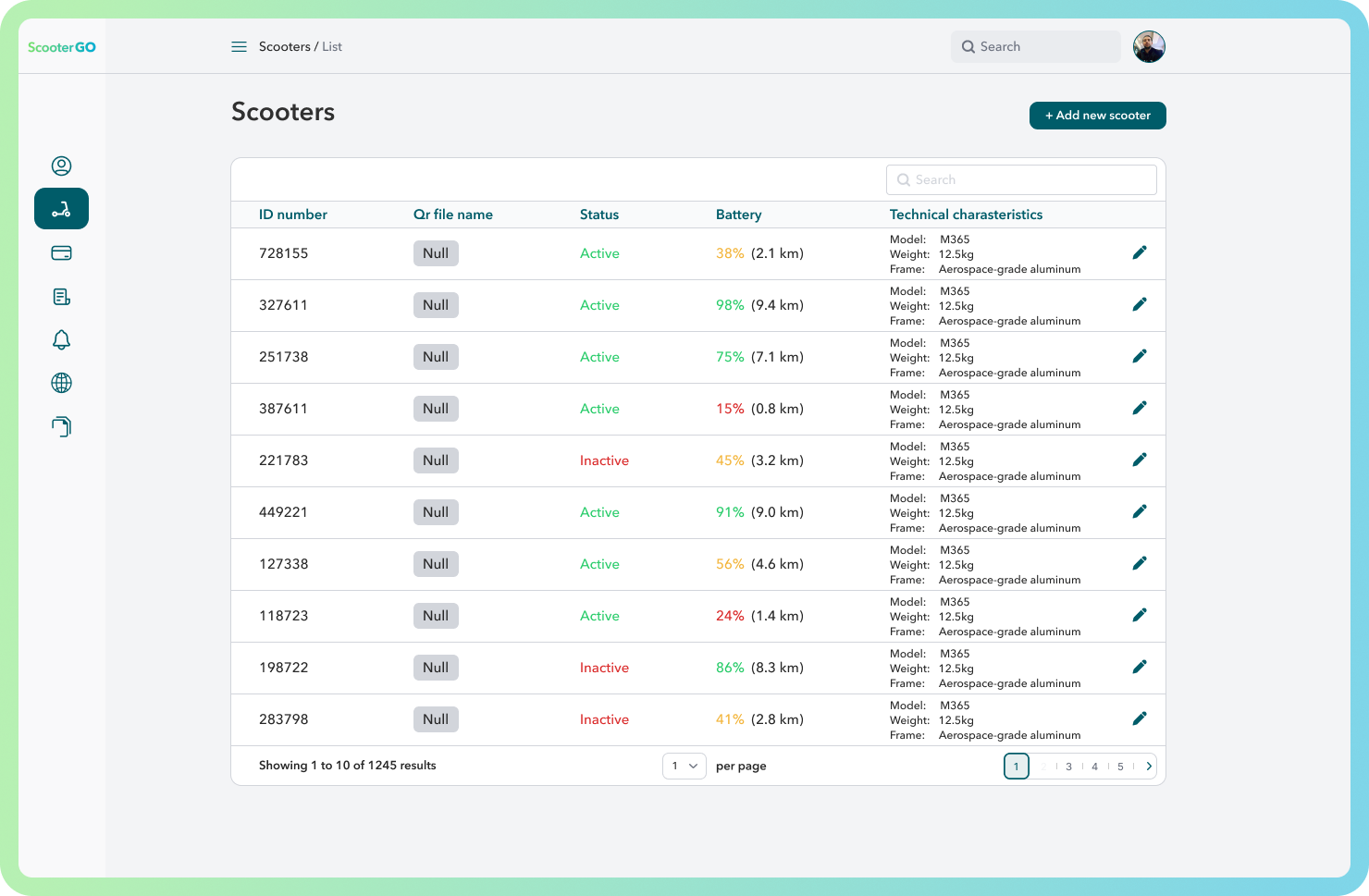
Sensors on a vehicle should indicate problems early. For example, if the battery consumption has suddenly spiked, this may be a signal to replace a battery. The sensors should also detect damage or misplacement, as well as extreme humidity or other conditions that influence the vehicle’s state.
Event-based alerts and notifications
Your fleet management system should receive notifications and event-based alerts if the vehicle has crossed the designated area, was damaged or has a low battery charge, for example. Your users should also receive notifications to their mobile applications on successful payment, start rides, low battery charge, and other information.
Mobile integration
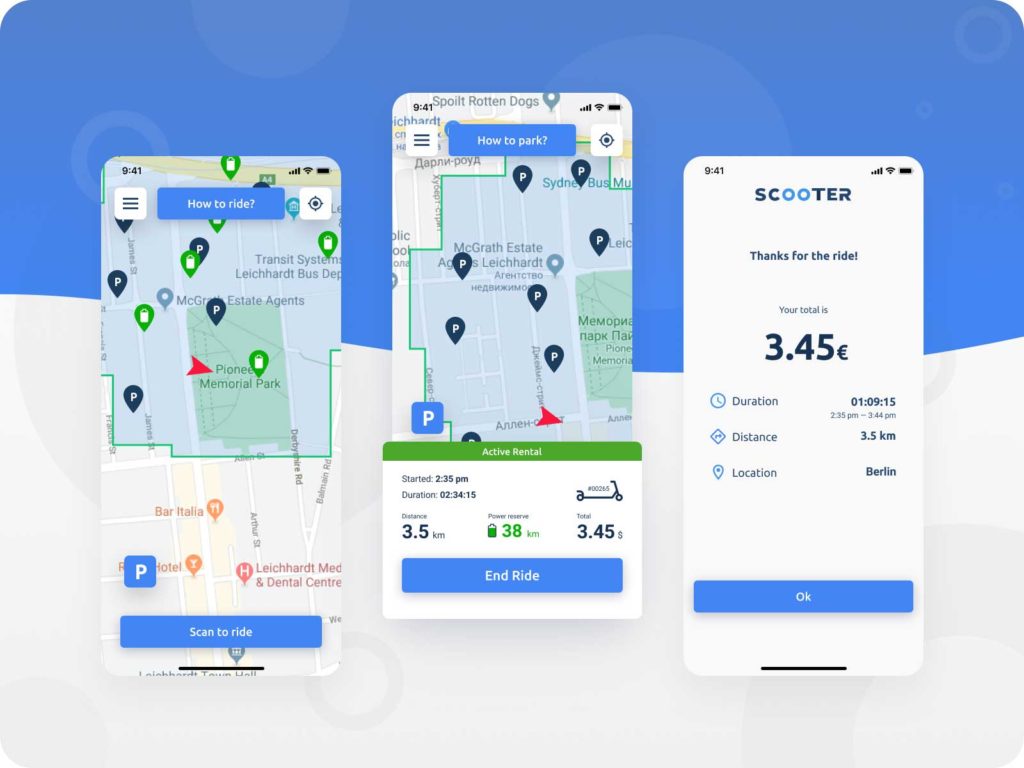
Your system should be integrated with your customer-facing and staff-designated mobile applications. Your customers should be able to register and use your micromobility service, and your staff needs to manage vehicles from anywhere at any time.
Data analytics and reporting
This feature provides fleet managers with valuable insights into their fleets’ performance. The system can analyze fuel consumption, driver behavior, and maintenance costs, providing fleet managers with detailed reports and actionable insights.
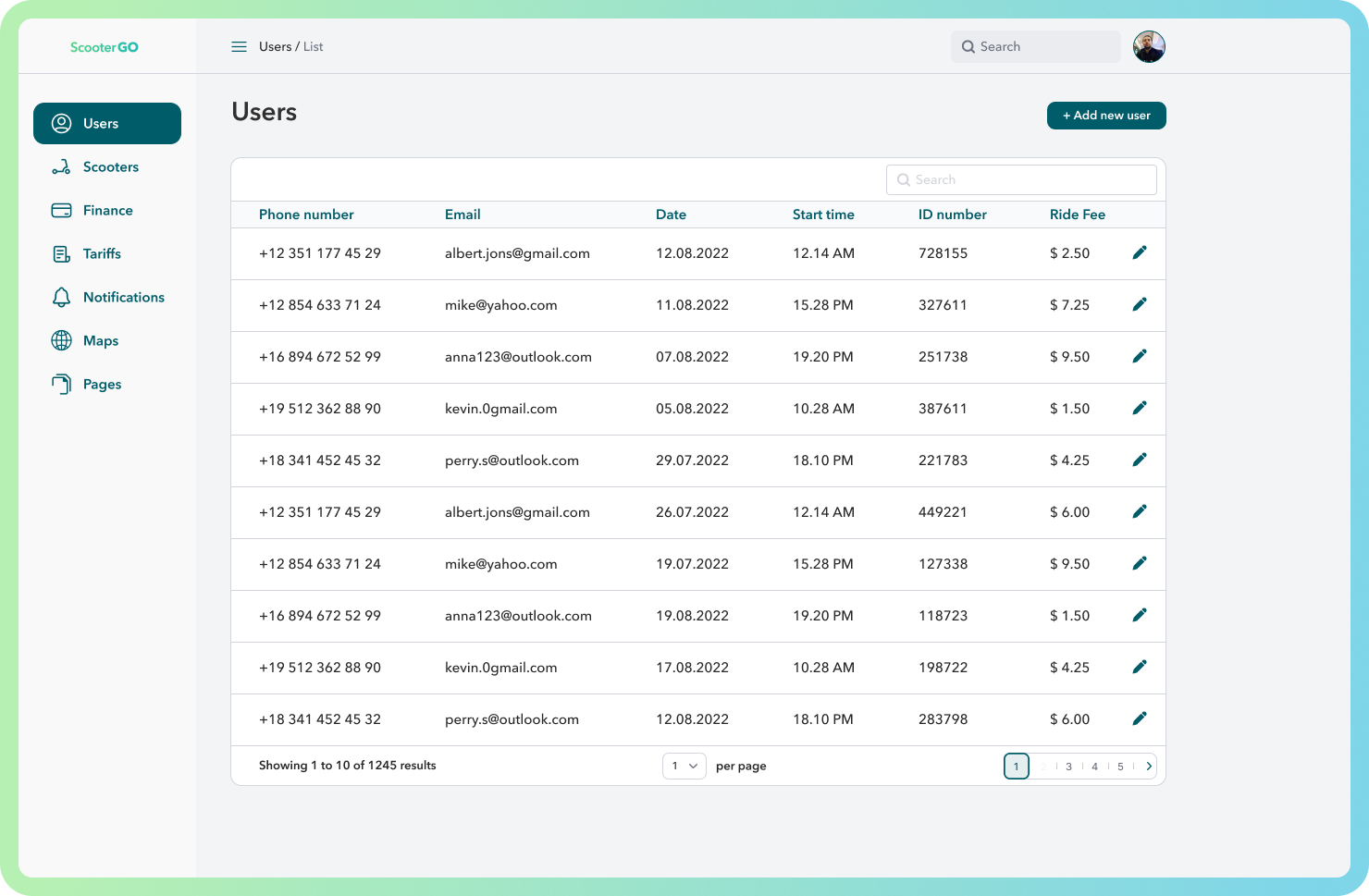
Vehicle management
Your staff should be able to manage, lock/unlock, and locate vehicles, as well as provide customer support through your fleet management system.
Payment gateway
Your micromobility management system should accept user payments and create financial reports, so you can see how much revenue you generate. A payment gateway will be integrated with your customer-facing app, so your users can pay with their mobile devices.
User management
Your administrators should be able to add, manage and delete users from the system, and also edit their information.
Custom vs off-the-shelf fleet management software
There are several ways to get micromobility fleet management software. You can purchase a white-label rideshare app, use SaaS products, or build your custom system from scratch. All these approaches have pros and cons, and your choice will depend on your deadline, budget, and resources.
Off-the-shelf fleet management software
Off-the-shelf fleet management software often comes with a white-label micromobility app, but you can also purchase it separately. At first, it seems like a no-brainer — instead of spending months on development, you quickly get your system up and running and either make a one-time payment or pay a monthly subscription.
Moreover, you can get everything at once: for example, a car-sharing app, a fleet management systems, help with integrating vehicles, and technical support.
With off-the-shelf systems, however, you have no control over features, security, and other aspects, because you can’t know what’s under the hood. They often can’t handle large fleets, so you’ll likely only get small fleet management software.
Such systems often have very limited customization abilities. If you want to expand your business to other cities or countries, offer more features, or handle more users, your off-the-shelf software may not be suitable.
Off-the-shelf solutions usually have limited customization abilities, and their providers often charge a monthly fee based on a number of vehicles on your fleet. This means that the more your business grows, the more money you’ll pay, and in the long run custom development may be more cost-effective
Custom micromobility fleet management systems
Custom micromobility fleet management systems, however, have no limits. You can always change and customize them based on your needs and create an architecture that will handle your growth.
A well-coded custom system will serve you for many years with proper maintenance, while off-the-shelf software is usually impossible to maintain and develop because of the rigid architecture.
There’s also a third solution, where you can take the best from both worlds. We at Mobindustry offer a ready-made scooter-sharing system with software for fleet management. Because we’re a custom software company first, we took care of the architecture beforehand, which can be customized and expanded at any time.
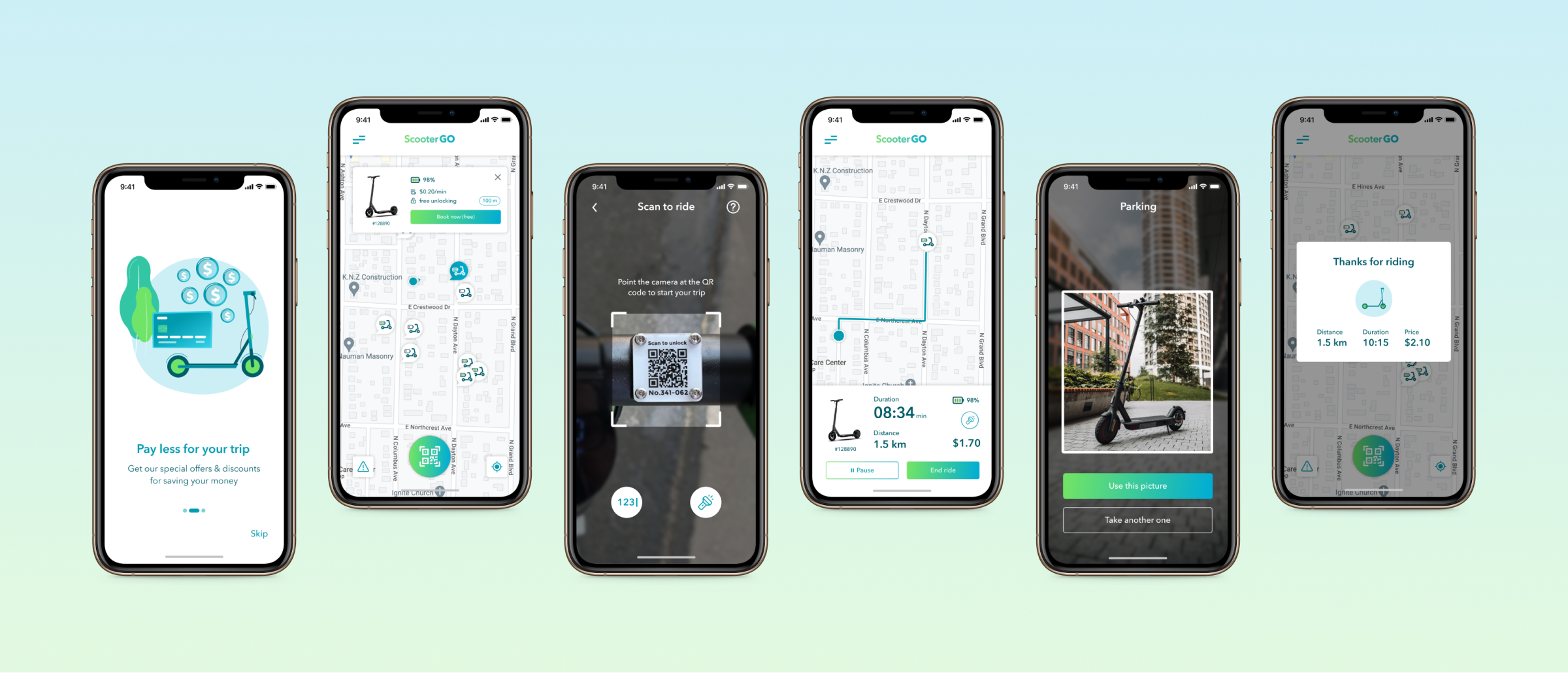
Let’s talk about how you can build a custom fleet management system that fits perfectly into your business operations and allows unlimited growth and improvement.
How to build a custom fleet management system for micromobility
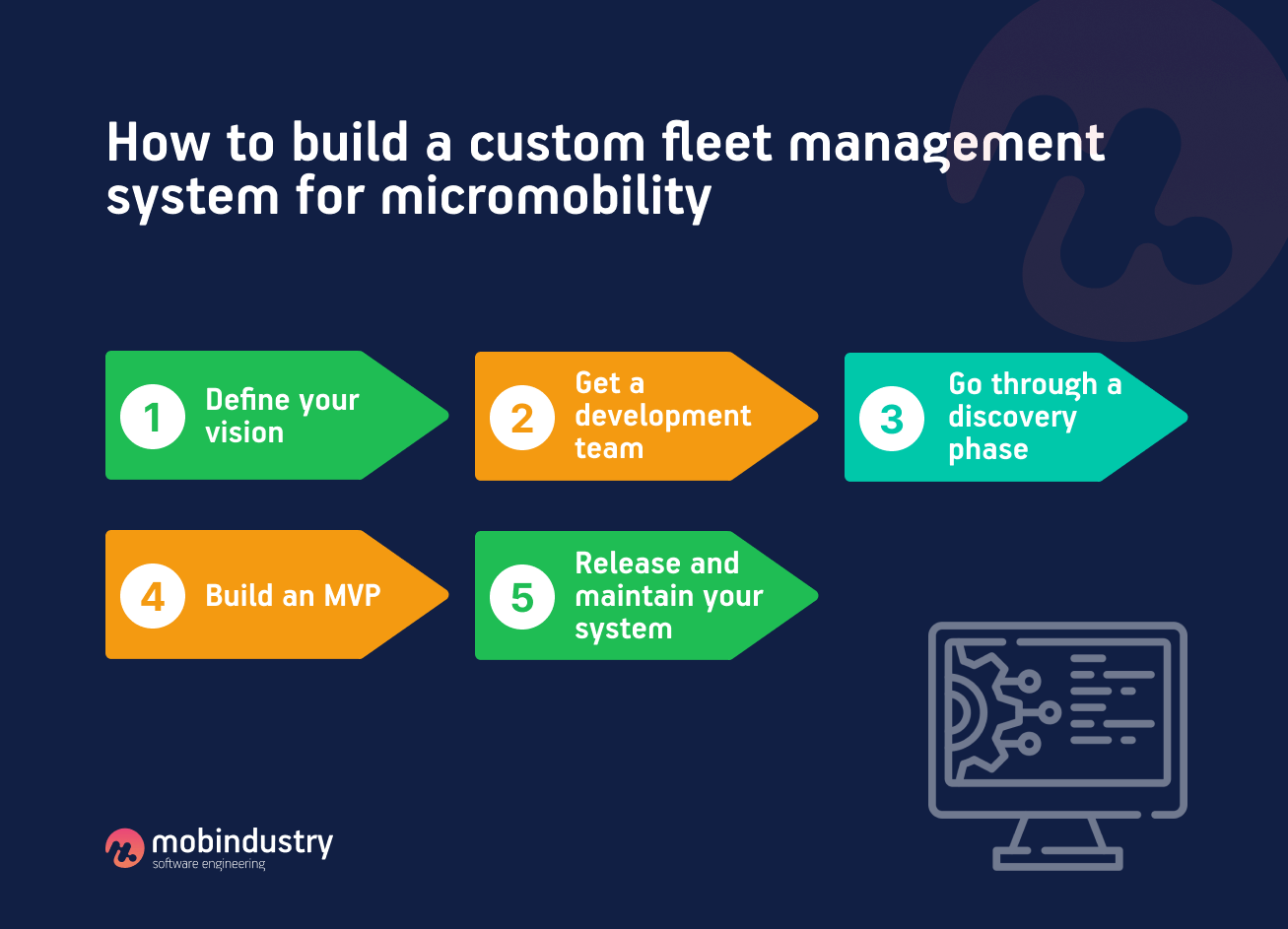
Define your vision
Depending on your type of micromobility business, be it bike fleet management or car-sharing fleet management, your system will be different. Research your competitors or try out an off-the-shelf system to find the features you’ll need for your solution.
Define your business goals and plan your future operations. How many vehicles are you planning to add to your network? How are you planning to grow and expand your business? What are the regulations in your area? Answer these questions before you find a development team.
Get a development team
Now, you need someone to develop your fleet management system. You can hire in-house developers and freelancers or partner with a fleet management software company. The last option is the most cost-effective and fast because you can get an entire team in just a few days.
You can collaborate with a software development company in any way imaginable: from hiring a dedicated team that will be on your project full-time to team augmentation, where you can hire any specialists for any period of time and amount of hours.
Go through a discovery phase
A discovery phase is a preparation phase that’s necessary for any project. It allows you to manage expectations and get exactly what your business needs at the end of your fleet management software development.
During the discovery phase, a business analyst extracts your business needs and objectives and turns them into a technical specification — a document that describes all features, requirements, and user flow. This specification is the most important document on the project, as every team member will reference it when working on your fleet management system.
Build an MVP
We always recommend launching an MVP first so that you can test it in real-life conditions and improve it if necessary instead of spending months and thousands of dollars on a fully-fledged solution that will need further changes.
To build an MVP, we prioritize the most critical features that implement them first. This way, you get a working solution fast and can test it for your actual business operations.
Release and maintain your system
Now, after you’ve integrated all your vehicles and implemented all the features, it’s time to release your fleet management system. The work doesn’t start there — all software requires regular maintenance to ensure smooth operation, so test your system regularly.
The maintenance activities include:
- Code optimization
- Security checks
- New feature implementation
- Updating your third-party services
- Performance optimization
How much does it cost to build a fleet management system?
The cost of building your custom fleet management system for a micromobility business depends on multiple factors:
- Your system’s size and complexity
- Number of features
- Number of third-party integrations
- Fleet size
- Hourly rate of your development team
The size and complexity of your system, and your developers’ hourly rate are two most important factors that will determine your fleet management software cost.
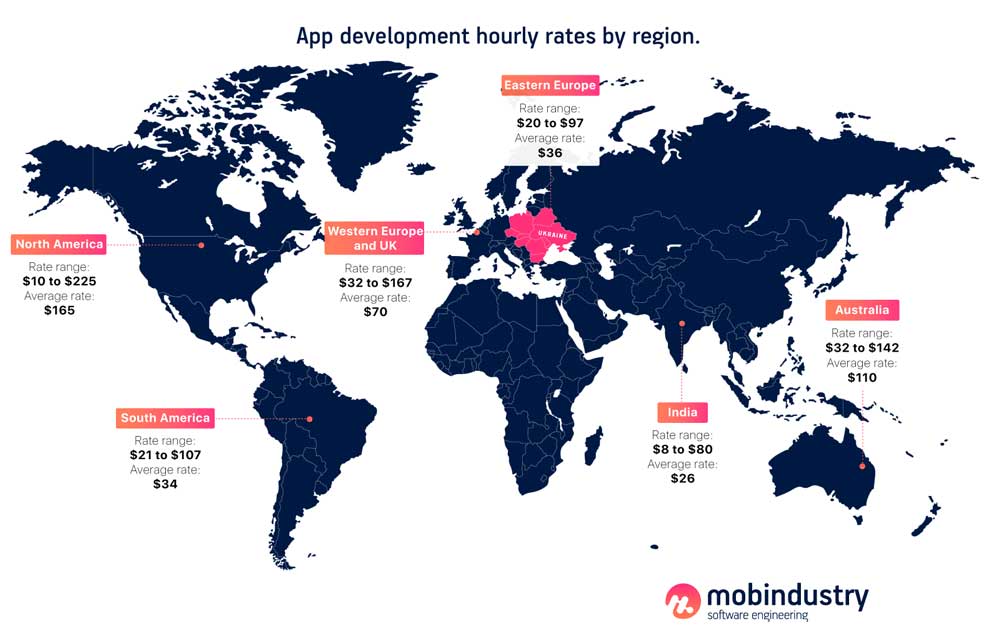
Going for the cheapest option isn’t the best strategy, but you can always save money by hiring overseas. For example, a team of Ukrainian developers can deliver a project for $30,000, while the same software with the same quality would cost $80,000 to develop in the US.
Custom fleet management systems for micromobility, on average cost between $7,000 and $20,000 to develop.
If you opt for an off-the-shelf solution, a fleet management system will typically cost roughly $35 per month per vehicle or between $3500 and $6500 per year for a fleet of ten cars. This means, that if you develop your own fleet management system, it will pay off in just a few years, especially if you have a large fleet.
We at Mobindustry offer an all-in-one solution for scooter-sharing businesses, that includes a customer-facing application and a fleet management system. Our solution costs only $30,000 as a one-time payment: no hidden or recurring fees.
How Mobindustry can help you build your fleet management system
We at Mobindustry are experts in building products for the sharing economy and micromobility businesses. We’ve built products from the ground up for power bank sharing, scooter sharing, and car sharing businesses.
We’ve even reworked a few white-label ride-sharing software for our clients when they stumbled upon limitations and inconsistencies in the code.
After gaining experience building multiple products for vehicle-sharing businesses, we created our own white-label app for scooter sharing. We aimed to create an app with scalable, reliable architecture that would allow maximum customization and flexibility.
We also didn’t want to limit the number of vehicles that would influence the price. Our solution costs the same no matter how big of a business you plan. For just $30,000, you get a customer-facing scooter-sharing app and a fleet-management system. All that without having to get into a lengthy electric scooter app development process.
If you need a fully custom fleet management system for your micromobility business, we’re capable of delivering the best possible solution that will serve for years to come. We also don’t abandon you on your journey: many of our clients stay with us for 4+ years for improvements, maintenance, and technical support.
If you’re looking for a reliable business and tech partner for your micromobility business, look no further and contact us.

